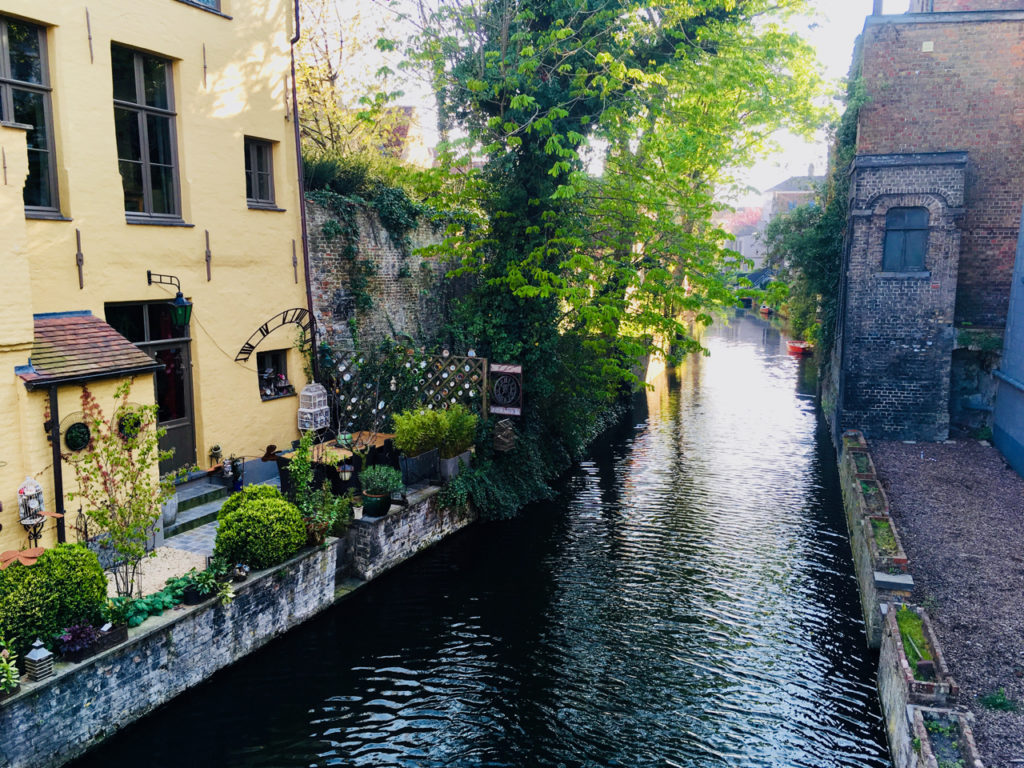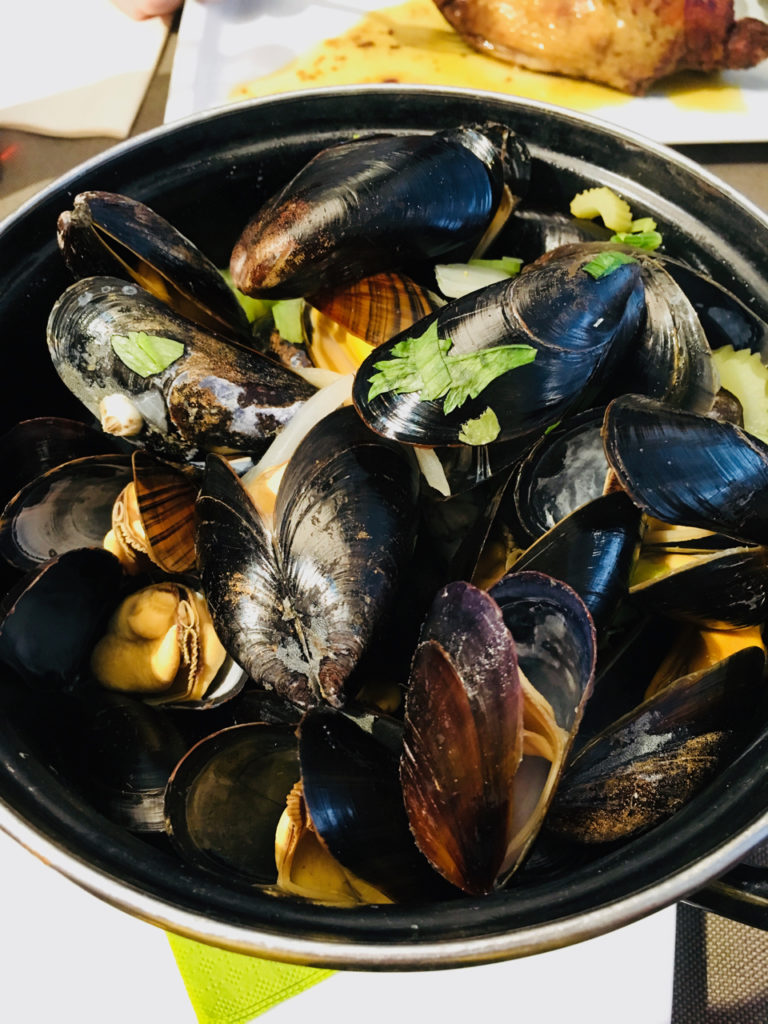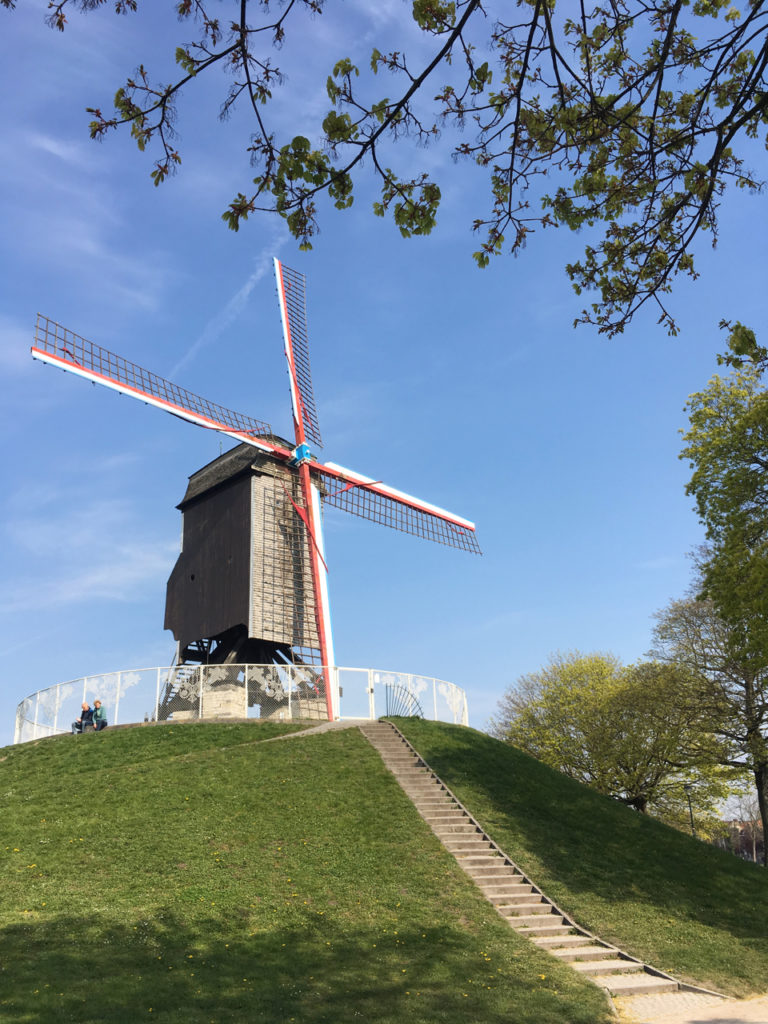I’ve always wanted to go to Bruges. It’s one of those places with a mystical aura that feels like an essential place to see in one’s lifetime. And then there’s Colin Farrell’s film In Bruges where it’s portrayed as a wonderful, fabled place and he calls it a “shit-hole” and you’re left wondering is it worth the visit? Bruges is indeed a beautiful town. It does have the famed cobbled streets and a whole town centre made up of old buildings and squares, there’s a clock tower and a windmill and everything you could want in a medieval mini-break, however, it is – as my very old guide book warned – very crowded and very expensive.
The approach to the old town, driving through the very flat, canal-lined suburban streets was lovely, and clean and orderly and the Hotel Navarra was absolutely perfect in almost every way. The town itself is lovely, with people wandering all over the cobbled streets while cars and bicycles vie for their rightful space on the roads. The buildings are old and they’re filled with chocolate shops and the sweet smell of waffles drifts upon the air. You’ve got your old churches and guild halls and town halls and a plethora of museums documenting the history of beer, chocolate, torture and hospitals. There are horse and carriage rides, boats cruising the canals over-burdened with tourists , queues at waffle shops and restaurants and cafes full of hungry tourists and locals. There are Chinese people eating fruit they bought from home in the square and American families wandering aimlessly with teenaged kids trailing behind uninterested. Closed cafes, churches and shop fronts feature heavily in the Bruges experience because they close for lunch for two hours (or more) and some things are closed on Monday and/or Tuesday including major sites, or maybe Sunday and Wednesday. Who can tell? Is there a good time to go? Who can know?
The chocolate museum costs £10 each to get in. We didn’t go in. When you order fries you have to pay extra for the ketchup or mayonaise. If you order mussells you have to pay extra for the provencale sauce. Order a cheesecake at a cafe oppposite the church where there is a Michaelangelo scultpure (that you have to pay to see) you’ll pay 12 Euros. Yes, that was us. Rubes. The crowds seemed to get worse as the week drew on, and I’m grateful we did some research and booked tables for dinner because the restaurants and cafes were all heaving by 6pm. We were lucky to find breakfast in amongst the cafes already full or not open till 10am. We had to queue for waffles and queue to eat fries.
The food was good. We had pretty great ribs at the all-you-can-eat-for-19 Euros Ribs and Beer. On the second night, we ordered mussels at Poules Moules which was well-reviewed online but turned out to be really rather ordinary. The best part was the waffles that we picked up at a mobile waffle-cart in one of the squares and the ‘real Belgian’ fries at Chez Vincent. We had to queue for these too, and pay extra for the sauce but the chihuahua in a push chair on the table behind us made it all worthwhile.
In terms of site-seeing, the best thing was the Groeningemuseum. Built on the site of the medieval Eekhout Abbey, it has a most welcome sense of calm that takes you out of the crowds lurking in every laneway and on every picturesque canal bridge. It houses six centuries of Flemish and Belgian paintings, from Jan van Eyck to Marcel Broodthaers and Hieronymus Bosch‘s The Last Judgement. The highlight was realising that Bosch was no more bonkers than the other Flemish painters who displayed their fair-share of crazy in the small, but well-curated permanent exhibition. The torture museum was graphic to say the least. I learned some new and terrible methods of torture and that the sweet scent of waffles makes the viewing of wax-work reinactments of torment all the more disagreeable. The Basilica of the Holy Blood was an unexpected highlight. The painted timber interior was one of the most unusual churches I’ve ever seen and for a couple of Euros we were able to get a close-up view of the famous vial containing the blood of Christ. It was bigger than I expected. Seeing a real, working windmill and climbing up inside it to see the enormous oak gears and grinders was pretty special but somewhat ruined by a sulking teenage son.
Typically, being crowded and expensive doesn’t always mean ‘no deal’ for me in terms of travel. The Sistine Chapel and the Tower of London are also expensive and crowded, but it doesn’t stop you from going. In the case of Bruges though, I would most certainly suggest that you try somewhere else first, maybe Ghent, Salzburg, Mostar or Český Krumlov. Or maybe even any old European town. Bruges is a pretty town but it doesn’t have more or less character than any other European town I’ve been to, and I’ve never felt like I’m being duped at every turn like I did in Bruges.
There’s a mystique about Bruges that I think comes from a New World perspective, where buildings older than 100 yrs are considered with heritage status – and that doesn’t really work for people living on or near the continent. All in all, it was a fun few days. Bruges is crowded and pricey, but it’s clean and they make very nice waffles.





